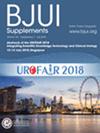Comparison of perioperative bleeding risk between direct oral anticoagulants in transurethral resection of prostate
IF 3.7
2区 医学
Q1 UROLOGY & NEPHROLOGY
引用次数: 0
Abstract
ObjectivesTo evaluate the perioperative morbidity and mortality associated with direct oral anticoagulants (DOACs) and warfarin for patients receiving transurethral resection of prostate (TURP).Patients and MethodsThis was a single‐centre, retrospective cohort analysis of patients who underwent TURP for benign prostate hyperplasia from April 2019 to December 2023. The primary objective was to evaluate the perioperative bleeding and thromboembolic risk between anticoagulated (AC) vs no‐AC patients. The secondary objective was to evaluate perioperative bleeding and thromboembolic risk between different formulations of DOACs. Patient demographics, prior treatment, prostate size, baseline bleeding risk, and operative details were collected. Bleeding and thromboembolic‐related morbidity were captured within a 3‐month postoperative period. Perioperative management of AC therapy was recorded, and all patients had their AC therapy withheld. Cohort characteristic between the AC vs no‐AC, and DOAC groups were analysed with two‐sided经尿道前列腺切除术中两种直接口服抗凝剂围手术期出血风险的比较
目的评估接受经尿道前列腺切除术(TURP)的患者使用直接口服抗凝药(DOAC)和华法林的围术期发病率和死亡率。患者和方法这是一项单中心回顾性队列分析,分析对象是2019年4月至2023年12月期间因良性前列腺增生接受TURP手术的患者。主要目的是评估抗凝(AC)与无抗凝患者的围手术期出血和血栓栓塞风险。次要目标是评估不同配方 DOACs 的围手术期出血和血栓栓塞风险。研究人员收集了患者的人口统计学资料、既往治疗情况、前列腺大小、基线出血风险和手术细节。采集了术后 3 个月内出血和血栓栓塞相关的发病率。记录了AC治疗的围手术期管理情况,所有患者都暂停了AC治疗。使用双侧 t 检验和卡方检验分析了 AC 组与无 AC 组和 DOAC 组之间的队列特征。还进行了进一步的逻辑回归分析,以确定组间的重要变量。结果队列中有 629 名患者,其中 113 名(18%)患者接受了 AC 治疗。据统计,接受阿昔单抗治疗的患者发生急性出血的风险增加了1.6倍,血尿时间延长14天的风险增加了11倍。与阿哌沙班相比,接受利伐沙班治疗的患者急性出血的风险在统计学上显著增加了2.21倍。接受 AC 治疗的患者在围手术期发生中风的风险有统计学意义的显著增加(无 AC vs AC:0.4% vs 2.7%,P = 0.01)。尽管暂停了治疗,但接受 AC 治疗的患者在围手术期更有可能出现血尿和中风。阿哌沙班引起的出血相关并发症似乎少于利伐沙班。
本文章由计算机程序翻译,如有差异,请以英文原文为准。
求助全文
约1分钟内获得全文
求助全文
来源期刊

BJU International
医学-泌尿学与肾脏学
CiteScore
9.10
自引率
4.40%
发文量
262
审稿时长
1 months
期刊介绍:
BJUI is one of the most highly respected medical journals in the world, with a truly international range of published papers and appeal. Every issue gives invaluable practical information in the form of original articles, reviews, comments, surgical education articles, and translational science articles in the field of urology. BJUI employs topical sections, and is in full colour, making it easier to browse or search for something specific.
 求助内容:
求助内容: 应助结果提醒方式:
应助结果提醒方式:


